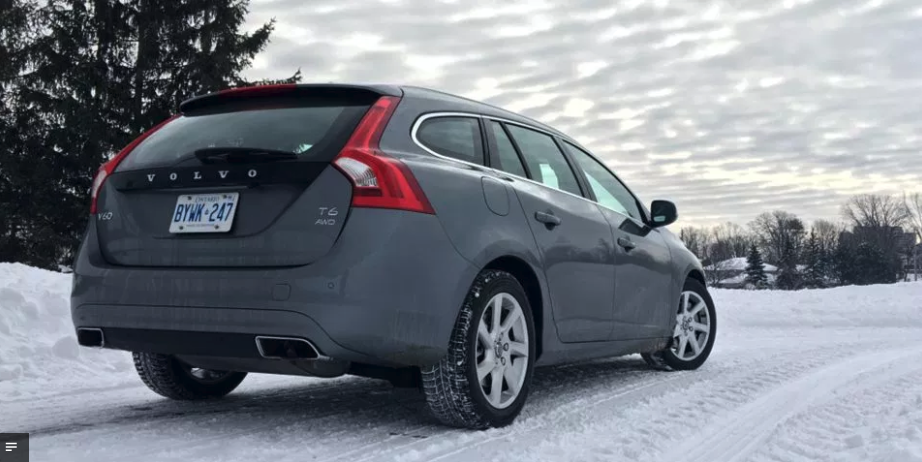Long-Term Test: 2016 Volvo V60 Sportwagon – Part 1

Story and photo by John LeBlanc
We’ve been lucky to sample a variety of new vehicles during our 60-day test drives. From a minivan to both small and large crossovers, to an electric car and a sports compact, our eight-week reviews bring out the good, the bad and sometimes the ugly that shorter test drives just can’t detect. Which makes our next long-term tester, the 2016 Volvo V60 Sportwagon — our first station wagon — such an interesting choice in a market that’s mad for crossovers, SUVs and trucks.
While a station wagon may seem out of step with today’s crossover-crazy buyers, the body style is still intrinsically linked to Volvo.
Back in 1953, the Swedish automaker saw an opportunity with commercial buyers and created the Duett, a wagon-like utility vehicle based on the PV444 sedan. During the ensuing decades, Volvo wagons evolved from a family car for Scandinavians to a status symbol for North American boomers, and finally a piece of car culture — fondly called “Swedish bricks.”
Volvo wagons have not been unfamiliar to the LeBlanc laneway. Over the years, we’ve had everything from a 1972 145, 1990 745 and 2005 V50 provide that quintessential Volvo wagon mixture of European style and dogged practicality. Which brings us to our 60-day test drive subject: the 2016 V60 Sportwagon, the only wagon left in Volvo’s current lineup until the larger V90 arrives later this year.
Although it only arrived in Canada last year, the five-passenger, compact V60 Sportwagon has been available in foreign markets since 2010. Unlike the latest midsize Volvo S90 sedan, V90 wagon and XC90 crossover, which are based on the automaker’s all-new Scalable Product Architecture platform, the S60/V60/XC60 models share a chassis from the days when the brand was owned by America’s Ford.
One way the V60 Sportwagon distinguishes itself is by offering buyers a lot of choices. Across seven models, you can get your Volvo wagon as a front-driver or with all-wheel-drive, and with four-, five-, or six-cylinder gas engines in five states of tune.
This year’s Volvo V60 Sportwagon base prices start at $40,600 for the T5 Drive-E FWD (with its turbocharged 2.0-litre four-cylinder, delivering 240 horsepower and 258 lb.-ft. of torque) and tops out with the limited edition, high-performance $67,295 V60 AWD Polestar (powered by a turbocharged 3.0-litre inline-six, with 345 horses and 369 lb.-ft. of torque). Rivals include 2016 versions of the $43,200 Audi A4 Allroad Quattro, $47,850 BMW 3 Series xDrive Touring and the forthcoming 2017 Mercedes-Benz C-Class wagon.
Our V60 Sportwagon is the $47,900 T6 Drive-E AWD Premier. In addition to traction at all four wheels, eight-speed automatic transmission and a 2.0-litre gas-four with 302 horsepower and 295 lb.-ft. of torque, we found a host of standard kit expected in this class. Highlights include Volvo’s Sensus central display, keyless drive, and Volvo’s City Safety dynamic vehicle and pedestrian detection system.
In addition, our tester came with $7,950 of optional packages that bumped our as-tested price to $55,850 — right in line with other well-equipped luxury wagons.
During our first two weeks in the V60 Sportwagon, our first impressions are positive. We’ve driven around 450 kilometres of mainly city driving at the tail-end of a long winter in Eastern Ontario, averaging an indicated 10.2 L/100 km. And although it’s been around for a few years, the V60 Sportwagon’s extensive refresh for 2014 has added a level of driving and cabin refinement that was missing when Volvos were under Ford management.
However, that doesn’t mean we don’t have a few questions we need answers to over the next six weeks.
First off, we’re curious if our four-cylinder V60 Sportwagon T6 Drive-E powerplant can match the feel of two more cylinders. Based on an all-new, direct-injected four-cylinder, the Drive-E strategy sees all new Volvos powered by this engine but then adds hardware in a stepped manner for more power. For example, the base 240-horsepower T5 Drive-E is turbocharged, the 302-horsepower T6 Drive-E adds a supercharger and the turbocharged/supercharged T8 Drive-E (as found in the Volvo XC90 crossover) adds a battery for 400 hp.
Secondly, before the advent of minivans, crossovers and SUVs, station wagons were the utility vehicles of their time. And upscale Volvos were seen much like buyers today see luxury crossovers. How practical will the V60 Sportwagon be for hauling people and their stuff?
And finally, Volvo has boldly come out with its claim that “No one will be seriously injured or killed in a new Volvo by 2020.” Towards that, our V60 Sportwagon adds a host of optional state-of-the-art safety tech. Will all these high-tech safety goodies be a hindrance or a help to the V60 Sportwagon’s driving experience?
To answer all the above, stayed tuned for our remaining 46 days to see just how relevant the 2016 Volvo V60 Sportwagon is in a world of crossovers.





![[del.icio.us]](https://www.straight-six.com/wp-content/plugins/bookmarkify/delicious.png)
![[Digg]](https://www.straight-six.com/wp-content/plugins/bookmarkify/digg.png)
![[Facebook]](https://www.straight-six.com/wp-content/plugins/bookmarkify/facebook.png)
![[Google]](https://www.straight-six.com/wp-content/plugins/bookmarkify/google.png)
![[Reddit]](https://www.straight-six.com/wp-content/plugins/bookmarkify/reddit.png)
![[StumbleUpon]](https://www.straight-six.com/wp-content/plugins/bookmarkify/stumbleupon.png)
![[Twitter]](https://www.straight-six.com/wp-content/plugins/bookmarkify/twitter.png)
![[Email]](https://www.straight-six.com/wp-content/plugins/bookmarkify/email.png)